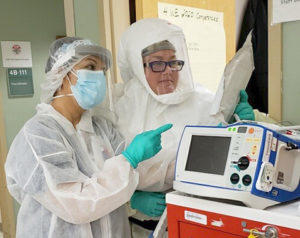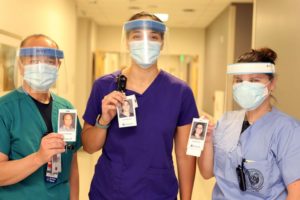
Nurses Carol Thompson and Lee Barela discuss supplies in the COVID-19 unit at the Eastern Oklahoma VA Health Care System, based in Muskogee. The Jack C. Montgomery VAMC has seen an increase of COVID-19 cases across Eastern Oklahoma and received help from staff from other VAMCs across the country. Photo from Sept. 25, 2020, VAntage Point blog
MIAMI — Medical advice urging the use of face masks to help bring the COVID-19 pandemic under control has become a political flashpoint in the United States, but a new VA study refuted some of the arguments against the strategy.
A study in Annals of the American Thoracic Society pointed out, “Current evidence, from observational studies to systematic reviews and epidemiologic modeling, supports the use of masks by the public, especially surgical masks, on mitigating COVID-19 transmission and deaths. However, public mask use has been heavily politicized with inconsistent recommendations by authorities leading to divided public opinion.”1
That has had an effect on perceptions about the benefits of face masks and, as a result, compliance with the preventive measure, according to researchers from Jackson Memorial Hospital, University of Miami Miller School of Medicine and the Miami VA Medical Center. The report cited an online U.K./U.S. survey finding that only 29.7-37.8% of participants thought that wearing a surgical mask was “highly effective” in protecting them from acquiring COVID-19.
Study authors described how discomfort from wearing a mask has been attributed to rebreathing CO2 and hypoxemia, with some opponents arguing that masks are lethal. In response, the study team sought to evaluate whether gas exchange abnormalities occur with the use of surgical masks in subjects with and without lung function impairment (i.e. chronic obstructive pulmonary disease).
“In order to demonstrate the changes in end-tidal CO2 (ETCO2) and oxygen saturation (SpO2) before and after wearing a surgical mask, we used a convenience sample of 15 house staff physicians without lung conditions (aged 31.1 +/- 1.9 years, 60% male) and 15 veterans with severe COPD (aged 71.6 +/- 8.7 years, FEV1 44.0 +/- 22.2%, 100% male),” the authors explained. “The patients needed to have a post-bronchodilator FEV1 <50% and FEV1/FVC <0.7 and were enrolled from the pulmonary function laboratory during a scheduled 6-minute walk test ordered to assess the need for supplemental oxygen. Because of COVD-19, the walks were done wearing a mask.
Researchers determined baseline measures on room air without a mask noninvasively using a Life Sense monitor (model Ls1-9R, Nonin Medical, Plymouth, MN), followed by continuous monitoring using a surgical mask.
Results indicated that, at 5 and 30 minutes, no major changes in ETCO2 or SpO2 of clinical significance were noted at any time point in either group at rest. With the 6-minute walk, subjects with severe COPD decreased oxygenation as expected, with two qualifying for supplemental oxygen.
“However, as a group, subjects with COPD did not exhibit major physiologic changes in gas exchange measurements after the 6-minute walk test using a surgical mask, particularly in CO2 retention,” researchers report.
The study did not measure changes in tidal volume or minute ventilation, but data collected suggests that gas exchange is not significantly affected by the use of surgical mask, even in subjects with severe lung impairment, according to the authors.

The physical therapy team at VA’s North Las Vegas Medical Center — . Ismael Magoto, Courtney Haia and Kaitlyn Burns, l to r — wears surgical masks and face shields to help protect patients against COVID-19. A new study suggested surgical masks present few if any dangers to wearers. Photo from July 8, 2020 VAntage Point blog
“The discomfort felt with surgical mask use has been ascribed to neurological reactions (increased afferent impulses from the highly thermosensitive area of the face covered by the mask or from the increased temperature of the inspired air) or associated psychological phenomena such as anxiety, claustrophobia or affective responses to perceived difficulty in breathing,” researchers emphasized.
They added that, with the use of N-95 masks, pCO2 may increase in lung-healthy users, although without major physiologic burden.
In this study, the intention was not to compare healthy versus diseased individuals but to assess the effect of using a surgical mask in two distinct populations, the authors advised, writing, “We acknowledge that our observations may be limited by sample size, however our population offers a clear signal on the nil effect of surgical masks on relevant physiological changes in gas exchange under routine circumstances (prolonged rest, brief walking).”
Researchers urged healthcare professionals to inform the public that “the discomfort associated with mask use should not lead to unsubstantiated safety concerns as this may attenuate the application of a practice proven to improve public health. As growing evidence indicates that asymptomatic individuals can fuel the spread of COVID-19,12 universal mask use needs to be vigorously enforced in community settings, particularly now that we are facing a pandemic with minimal proven therapeutic interventions.”
VA requires everyone entering its facilities to wear a mask that covers their mouth and nose. The facilities ask patients and visitors to bring their own mask if they can but will provide masks if necessary.
The VA policy makes an exception for those wearing oxygen masks, saying they don’t need to wear a separate facemask. It advises, however, that those veterans might be asked to wait in a designated space until appointment time, away from others in the waiting room.
- Samannan R, Holt G, Calderon-Candelario R, Mirsaeidi M, Campos M. Effect of Face Masks on Gas Exchange in Healthy Persons and Patients with COPD. Ann Am Thorac Soc. 2020 Oct 2. doi: 10.1513/AnnalsATS.202007-812RL. Epub ahead of print. PMID: 33003954

